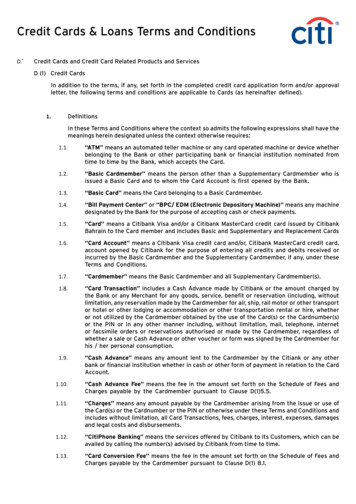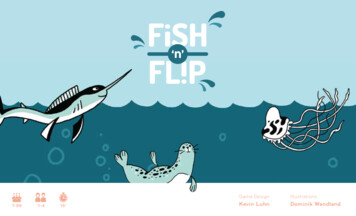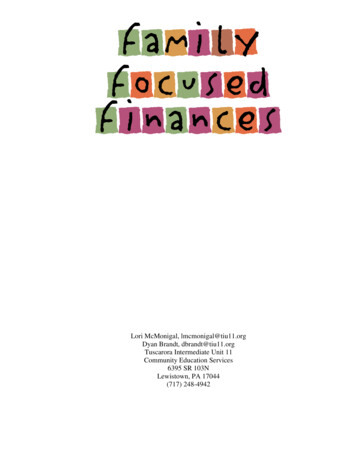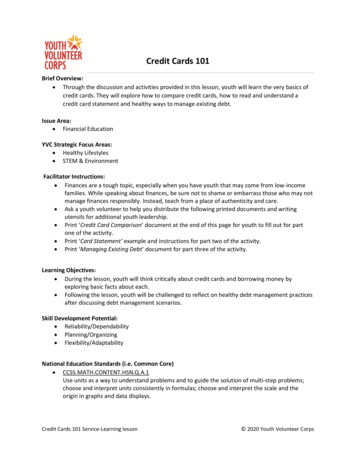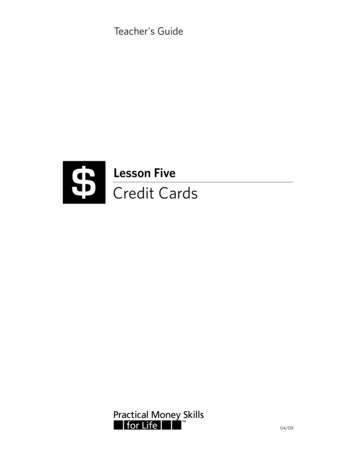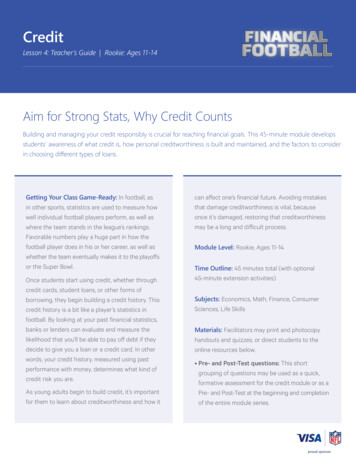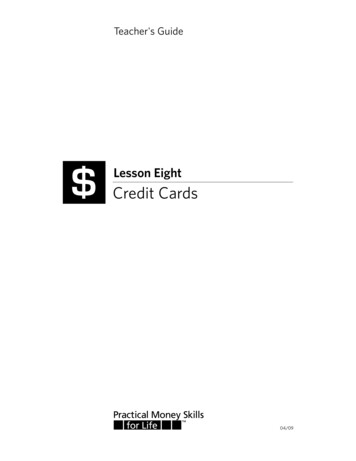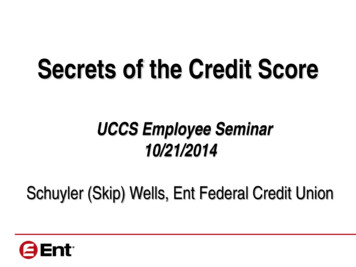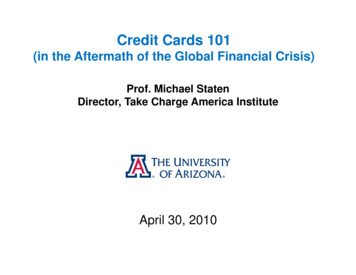
Transcription
Credit Cards 101(in the Aftermath of the Global Financial Crisis)Prof.Pf MiMichaelh l StatenSt tDirector, Take Charge America InstituteApril 30, 2010
The Credit Card Industry Has BeenSlSlammedd byb ThreeThRelatedR l t d EventsEt The global financial meltdown in 2008 dried up manyof the traditional sources of funding that credit cardcompanies used to make loans credit availability on credit cards started totighten in fall 2008
The Credit Card Industry Has BeenSlSlammedd byb ThreeThRelatedR l t d EventsEt The gglobal financial meltdown credit availabilityy started totighten in fall 2008 The sharp recession that was created by the financialmeltdown has caused losses to soar (and they willstabilize at an historically high rate in 2010)– Example: Bank of America announced record chargeoffrates of 13.5% of total balances owed in December 2009– Since the 4th quarter of 2008, card issuers have beenscrambling to reduce risk slashed trillions of of unused credit lines for millions ofcardholders, AND sharply raised the qualifying standards fora new credit card
Credit Card Loss Rates and PersonalB k t iBankruptcies
The Credit Card Industry Has BeenSlSlammedd byb ThreeThRelatedR l t d EventsEt The global financial meltdown in 2008 dried up many of the traditionalsources of funding that credit card companies used to make loans credit availability started to tighten in fall 2008 The sharpThhrecessioni createdd byb theh financialfii l meltdownldhash causeddlosses to soar trillions of of unused credit lines cut for millions ofcardholders CARD Act of 2009 will change the industry’s revenuemodel going forward (for the worse)– Why? Reduced pricing flexibility, in a market already saturated bytoo many issuers and too many products
Overview of Sessions #1 and #2Objective: Understand the workings of the credit cardbusiness so as to understand thelikely impact of the landmark CARDAct passed in 2009 Session #1Credit Cards 101: a brief overviewof the credit card industry in the U.S. Session #2Credit Card Reform Act of 2009 Discussion:DiiWhatt dWhdoes it allll mean forf consumersin the months and years ahead
Evolution of Consumer Payment Devices Four transformational leaps in the evolution ofpaymentst thatth t facilitatef ilit t our day-to-dayd t d transactionstti– Switch from barter to coin (around 700 BC)– Introduction of paper checks (12th century, Venetians)– Intro of paper currency (17th century) 1690, Massachusetts Bay Colony, first government in western world toissue paper money. Source WSJ, 4/23/2010– Payment card (mid-20th century) Paperg platespMetal chargePlastic credit cardsDigital, pure electronic transactions
Evolution of Consumer Payment Devices Today, itit’ss not the card itself that matters . itit’ss thedigits– The account number provides the unique link toyou, theh customer The digital age has revolutionized the concept ofmoney How the digits are actually stored is merely a detail––––embossed number on a cardmagstripe on back of cardRFID transmissionti i throughthh “close“ lproximity”i it ” devicesd ipure electronic form as in e-commerce over the internet
Taxonomy of Payment Cards Credit Cards– General Purpose cards VisaMasterCardDiscoverAmerican Express– Proprietary (store) cards Debit cards (linked to a checking account) Prepaid Cards/Stored value cards Mobile/Contactless payment devices (link to either a credit cardaccount or a checking account – or some other source of funds)
A Word on Credit vs. Debit Cards(Visa and MasterCard logos)Credit Cards Versatile, widely accepted payment card productAllows for payment in full each monthAlso, can revolve a purchasebalance for many monthsC dh ld requiredCardholderi d tot makeka minimum monthly paymentDebit (Check) Cards A versatile widely accepted payment card productLinked directly to cardholder’s checking accountUsed like a checkPurchase is deducted directly fromcardholder’s checking account
General Purpose Credit Cards, 2006(generally accepted across many types of merchants) Visa brand:– 6.7 million merchant locations in U.S– 24 million merchant locations worldwide MasterCard brand:– 6.8 million merchant locations in U.S.– 25.1 million merchant locations worldwide American Express– 3.0 million merchant locations in U.S.– 5.05 0 million merchant locations worldwide Discover– 4 million merchant locations in U.S.
Some Basics of General Purpose CreditCards Visa and MasterCard are “brands”“brands”, not issuers: thatis, Visa and MasterCard do not issue credit cards– Used to be “associations” owned by thousands of memberbanks– Both Visa and MC are now separate, for-profit, corporateentities (Visa, Inc.; MasterCard Worldwide)– Both are now traded on the NYSE
Some Basics of General Purpose CreditCards Visa and MasterCard are “brands”,brands , not issuers Only banks can issue Visa and MC products, under affranchisehi licenselifromftheth respectiveti companiesiExamples:– Bank of America issues mostlyy Visa pproducts– Citibank issues mostly MasterCard products (but some Visa)– Your local credit union probably issues one or the other butnot both
Some Basics of General Purpose Cards Visa and MasterCard are “brands”, not issuers Only banks can issue Visa and MC products, under a franchiselicense from the respective companies American Express and Discover Financial Servicesare also general purpose card brands, but different inimportant ways– Each is the brand AND the issuer– Each company has a unit chartered as a national bank, thatpermits them to issue a general purpose credit card– American Express is now partnering with some other banksto jointly issue AMEX cards to the bank’s customers
Who Does What?L t’ ConsiderLet’sCid VisaVi as an ExampleEl Visa– Promotes the “brand”brand– Signs up merchants to accept the brand constantly changing as merchants go in and out of business constantlyy expandingpg overseas– Maintains the transaction processing network (vast networkof computer terminals and “switching/routing” equipment)– Develops new payment card products (credit, debit, smartcards; e-commerce applications; other electronic paymentdevices) Bank Card Issuers– Market specific payment card products to consumers– Make all credit and card-issuing decisions (pricing; productfeatures; accept/reject criteria)– CoCollectionect o activityact ty oon aall accouaccountsts
The Major Players Among Card Issuersas of 2009 (ranked by amount owed)1.12.3.4.5.6.7.8.99.10.JP Morgan ChaseBank of AmericaCitigroupAmerican ExpressCapital OneDiscoverWells FargoHSBCUS BankUSAA Federal Savings Bank
Consolidation in the General Purpose CreditCard Market19932007Other6,000 13%Other6 000 6,00027%6 thru 1015%Top 1054%11 thru2019%Source: Card Industry DirectoryTop 572%
Contrast with Debit/Check Card Issuers, 2007:Much Less ConsolidationTotal Debit CardMarket10 Largest IssuersCitiU.S. 5%Bank6%Top 1026%Others10%Bank ce: Card Industry Director, 2007WAMU11%WellsFargo16%
Debit and Credit Card Products Operate inVery Different Competitive Environments Most general-purpose credit cards are issued toconsumers who do NOT have checking or depositaccounts with issuing bank– In 2001, only 17% of all Visa/MC credit products were issuedto consumers who already had at least one bankingrelationship with the issuing bank– RESULT: credit cards are marketed to expand the bank’scustomer base Opportunity for cross-sellingcross selling other bank products Lots of competition on card features AndAnd, the potential for generating revenue from thepayment product is much higher on credit cards thandebit cards
So, Credit Card Issuers Try to Differentiate TheirC d ProductsCardP d t tot GetG t ThemThIntoI t YourYWalletW ll t Price Competitionp– Interest rate (on revolving balances)– Fees (annual; overlimit fee; late fee; cash advance fee;foreign currency exchange fee)– Balance transfer offers Amount of credit line Rewards (Cash back rebates; airline miles) Affinity relationshipsIn contrast, debit cards are pretty much all the same
So, How Do Banks Make Money onCredit Cards?Step 1:–The card-issuingcard issuing bank gets a small percentage (1(1.55 – 2%) of everydollar chargedStep 2:–Many customers choose not to pay thebalance in full each monthThe issuer collects interest income on the portion of the balance“revolved”revolved from month to monthStep 3:–Your bank card issuer wants you to use thecard!Many customers have late payments, or goover their credit limitsThe issuer typically charges a penalty fee, and may raise theinterest rate (but this is harder now after the CARD Act)
Source of Bank Card Revenues, 2006(Total 115 billion)Other Fees8%Penalty Fees6%Other1%Interchange20%Interest65%Source: Card Industry Directory, 2007
Key Players in the Routing of A TypicalCredit Card Purchase C dh ld (whoCardholder( h initiatesi iia purchase)h) Merchant (who transmits info from the credit card/paymentdevice) Acquiring bank (who the merchant hires to “talk” to theauthorization network and eventually collect payment fromiissuingi bank)b k) Visa Network (verifies cardholder ID, available credit, and getsauthorization for the transaction)) Issuing Bank (the bank that issues the credit card, approvesthe transaction and bills the customer via the monthlystatement)t tt)
How the Digits on Your Visa Credit CardAllAllowYouY ToT BuyB thatth t FlFlatt PPanell TVCardholderMerchantAcquirerVisaNetIssuer
Who Pays for all of this TransactionClearing Activity? Merchant Discount Fee–On average, the merchant pays about 2% of the value ofevery transaction made with a general purpose credit card Issuing bank gets about 80% of that (or about 1.6%of the transaction value) Acquiring bank gets the rest Visa Network gets paid by the Issuing bank andAcquiring bank through their franchise fees
FYI: Source of Bank Card Expenses, 2006(Total 87 billion)Fraud1%Cost of Funds33%Marketing &Operations38%Chargeoffs28%Source: Card Industry Director, 2007
Credit Card Accountability,RResponsibilityibilit andd DisclosureDi lActA t President Obama signed into law May 2222, 2009 Most features became effective 9 months aftersigning February 2010.“[the legislation] marks a turning point for Americanconsumers and ending the days of unfair rate hikesand hidden fees.fees ”
A Digression Close to Your Students:What Do We Know About College StudentCredit Marketing as of Early 2010? Survey data derived from nationwide college studentsurvey 4-year4i tit tiinstitutions Undergraduates Source: Student Monitor– (Ridgewood, NJ. http://www.studentmonitor.com)
Undergraduates with General Purpose Cardsin Their Own NamesFreshmen 2004Freshmen 20102 Cards 3 6% 1%2 Cards5%3 2%1 Card19%1 Card24%0 Cards69%Source: Student Monitor, Spring 2004 and 2010 Surveys0 Cards74%
Undergraduates with General Purpose Cardsin Their Own NamesAll Students 2004All Students 20102 Cards6%2 Cards 3 Cards3%11%3 3%1 Card26%1 Card32%0 Cards54%Source: Student Monitor, Spring 2004 and 2010 Surveys0 Cards65%
When First Card in Own Name was ObtainedDon'tKnow3%Soph Year 10%While in H.S.33%FreshFh YearY25%Source: Student Monitor, Spring 2010 Survey.After H.S./BeforeCollege16%
Methods of Obtaining General Purpose Cardsin Students’ Own NameName, 2004All Other/Don'tKnow8%Display offcampus6%Direct Mail Offer37%On campus repor display7%In-person at abank29%Source: Student Monitor, Spring 2004 Survey.Via telephone8%Vi InternetViaI5%
Methods of Obtaining General Purpose Cardsin Students’ Own NameName, 2010OtherInternet ad/offer3%Direct Mail Offer11%4%Don't Know8%Display offcampus2%On campus repor display2%Source: Student Monitor, Spring 2010 Survey.Calling 800number8%Card companywebsite10%In-person at abank40%
QUESTIONS?
Overall, What Does All of This Mean forCredit Card Companies and Consumers?For Credit Card Availability. . . . Higher eligibility standards for new accounts– Higher FICO score, etc.Lower credit limits and possibly fewer cases ofmultiplep accounts perp customer (to( limit issuer risk))
Overall, What Does All of This Mean forCredit Card Companies and Consumers?For Pricing.g . Higher credit card interest rates Return of annual fees– But, possibly waived for cardholders who exceed spendingthresholdsRewards programs may still be OK – but those cardsmay carry even higher annual fee or interest rate
The Credit Card Industry Has Been Sl d b Th R l t d E tSlammed by Three Related Events The ggylobal financial meltdown credit availability started to tighten in fall 2008 The sharp recession that was created by the financialThe sharp recession that was created by the financial meltdown has caused losses to soar (and they will stabilize at an historically high rate in 2010)



